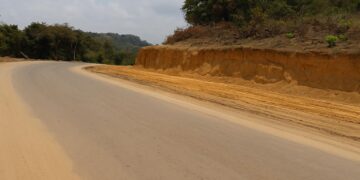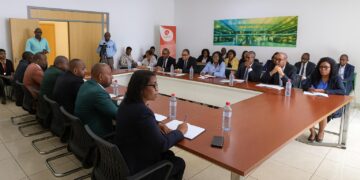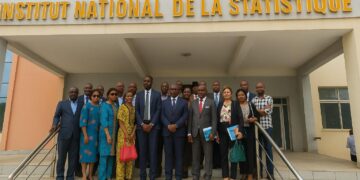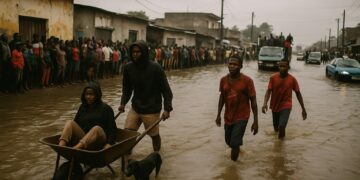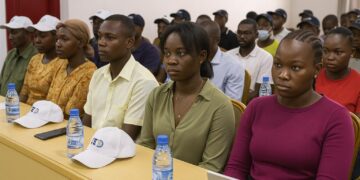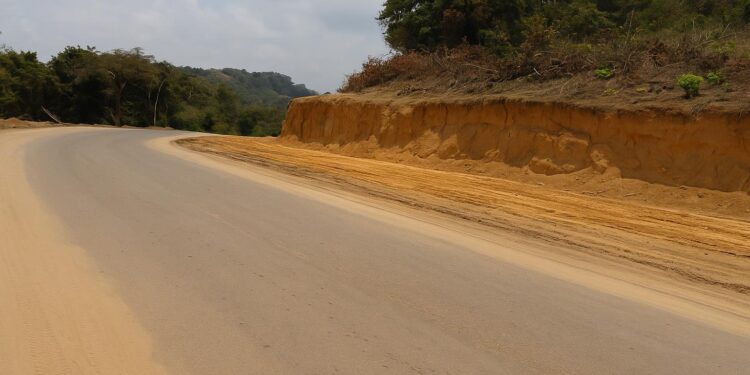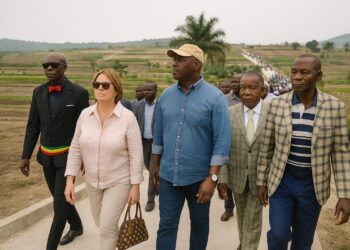RN2 overhaul enters decisive stage
The 388-kilometre Brazzaville-Ollombo segment of National Road 2, lifeline for northern Congo’s timber, agro and mining supply chains, is undergoing its first full resurfacing since 2012, according to the Ministry of Equipment and Public Works (Les Dépêches de Brazzaville).
Contractors have already laid a fresh wearing course on 140 kilometres, cleared drainage ditches and installed new kilometre markers. Yet the symbolic victory, say site engineers, is the widening of the razor-sharp Mbamba bend, long feared by truckers ferrying logs to the port of Brazzaville.
Mbamba bend: engineering risk hotspot
Perched on a sandstone escarpment, the curve tilts eleven degrees and narrows to five metres, forcing heavy rigs into counter-steering sequences that tax brakes and transmissions. Accident records from the gendarmerie list sixteen serious incidents over the past five years, mostly brake overheating on downhill approaches.
The redesign trims the incline, realigns the camber and adds a two-metre shoulder, while rockfall nets secure the uphill face. A Chinese-Congolese consortium led by China State Construction Engineering provided the geotechnical modelling under a design-build contract signed in 2022 (Ministry communiqué).
Brazzaville-Ollombo corridor and trade flows
RN2 channels about 1.2 million tonnes of freight a year, including sawn timber, cassava, cocoa and construction inputs destined for the capital and onwards to Kinshasa via the Congo River, African Development Bank logistics data show. The corridor’s rehabilitation is expected to cut average transit time by three hours.
Hauliers such as Société Transport du Nord forecast fuel savings of 15%, arguing that smoother gradients and fewer detours will offset recent diesel price adjustments. Passenger services equally anticipate higher frequency on the Brazzaville-Ouesso axis once the Mboka transport hub at Ollombo becomes operational in 2025.
Funding mix and potential toll strategy
The government finances 55% of the 92-billion-CFA franc programme through the public investment budget, complemented by a 35-billion-franc concessional loan from Exim Bank of China and a 6-billion-franc grant from the Saudi Fund for Development, according to the 2023 Finance Law.
Officials underline that routine maintenance remains the Achilles heel of African trunk roads, often leading to expensive rebuilds after only seven years of service. A feasibility study carried out with the assistance of the World Bank recommends installing three additional toll and axle-weight stations to secure user-fee revenue.
Transport unions initially voiced concern over tariff escalation, but the Ministry insists that any future toll of 500 CFA francs for light vehicles and 2,500 CFA francs for 40-tonne trucks would be offset by reduced vehicle depreciation and predictability of journey times, a position echoed by the Chamber of Commerce.
Supply chain benefits for local SMEs
Civil-works procurement has already generated contracts for quarries at Ngabé and steel fabricators in Ignié, feeding aggregates and guard rails to the site. The National Committee for Local Content estimates that 38% of expenditure to date has remained within Congolese SMEs, exceeding the 30% threshold set in recent decrees.
Logistics operators anticipate that once weighbridges become operational, compliance services such as axle calibration, tyre retreading and cab telematics will proliferate along the corridor, sustaining jobs for mechanics and IT technicians returning from the diaspora, a key objective of the national skills repatriation programme.
Governance, maintenance, resilience
The Public Works Ministry plans to outsource maintenance to a performance-based contract, with indicators on surface roughness, drainage clearing and vegetation control. Such contracts, piloted on RN1, have demonstrated cost reductions of 18% compared with force-account methods, according to the state audit office.
Climate-screening by the Congo Basin Blue Fund concluded that the route faces increasing precipitation intensity. Designers have therefore expanded culvert diameters, specified polymer-modified bitumen and introduced early-warning sensors that flag embankment saturation to the road agency’s control room via the BEAC backbone fibre network.
Environmental safeguards in Congo Basin
The project lies within the buffer zone of the Léfini wildlife reserve, habitat for lowland gorillas and forest elephants. Environmental Impact Assessments mandated wildlife corridors, noise abatement during nesting seasons and reforestation of borrow pits using native acacia saplings supplied by the National Reforestation Fund.
Community engagement committees in Ngo and Djambala have signed benefit-sharing accords that earmark 1% of project value for schools and boreholes. Observers from the Congolese Observatory of Human Rights report that grievance mechanisms are functional and that compensation for involuntary resettlement has been disbursed.
Investor outlook and next milestones
The second construction season, starting in July, will tackle the remaining 60 kilometres, upgrade signage to retro-reflective standards and install a 30-kilometre fibre conduit for future 5G roadside services. Completion is slated for late 2025, subject to the arrival of asphalt pavers currently shipping from Shanghai.
Against a backdrop of steady sovereign credit metrics and the forthcoming hydrocarbons licensing round, infrastructure analysts at Fitch Solutions view the RN2 upgrade as a bellwether for blended-finance road deals across Central Africa, noting that predictability in toll policy will be decisive for mobilising domestic pension funds.


